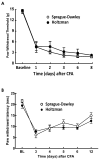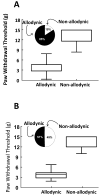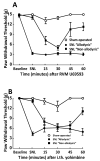Engagement of descending inhibition from the rostral ventromedial medulla protects against chronic neuropathic pain
- PMID: 21745713
- PMCID: PMC3222148
- DOI: 10.1016/j.pain.2011.06.008
Engagement of descending inhibition from the rostral ventromedial medulla protects against chronic neuropathic pain
Abstract
A puzzling observation is why peripheral nerve injury results in chronic pain in some, but not all, patients. We explored potential mechanisms that may prevent the expression of chronic pain. Sprague Dawley (SD) or Holtzman (HZ) rats showed no differences in baseline sensory thresholds or responses to inflammatory stimuli. However, spinal nerve ligation (SNL)-induced tactile allodynia occurred in approximately 85% of SD and 50% of HZ rats, respectively. No apparent differences were observed in a survey of dorsal root ganglion or spinal neuropathic markers after SNL regardless of allodynic phenotype. SNL-induced allodynia was reversed by administration of lidocaine within the rostral ventromedial medulla (RVM), a site that integrates descending pain modulation via pain inhibitory (ie, OFF) and excitatory (ie, ON) cells. However, in SD or HZ rats with SNL but without allodynia, RVM lidocaine precipitated allodynia. Additionally, RVM lidocaine produced conditioned place preference in allodynic SD or HZ rats but conditioned place aversion in nonallodynic HZ rats. Similarly, RVM U69,593 (kappa opioid agonist) or blockade of spinal α(2) adrenergic receptors precipitated allodynia in previously nonallodynic HZ rats with SNL. All rats showed an equivalent first-phase formalin responses. However, HZ rats had reduced second-phase formalin behaviors along with fewer RVM OFF cell pauses and RVM ON cell bursts. Thus, expression of nerve injury-induced pain may ultimately depend on descending modulation. Engagement of descending inhibition protects in the transition from acute to chronic pain. These unexpected findings might provide a mechanistic explanation for medications that engage descending inhibition or mimic its consequences.
Copyright © 2011 International Association for the Study of Pain. Published by Elsevier B.V. All rights reserved.
Figures





Comment in
-
Descending controls: insurance against pain?Pain. 2011 Dec;152(12):2677-2678. doi: 10.1016/j.pain.2011.07.003. Epub 2011 Aug 15. Pain. 2011. PMID: 21840645 No abstract available.
References
-
- Barbaro NM, Heinricher MM, Fields HL. Putative pain modulating neurons in the rostral ventral medulla: reflex- related activity predicts effects of morphine. Brain Res. 1986;366(1-2):203–210. - PubMed
-
- Biaggioni I, Robertson D. Adrenoceptor Antagonist Drugs. In: Katzung BG, editor. Basic & Clinical Pharmacology. Vol. 11e. The McGraw-Hill Companies, Inc.; 2009. http://www.accessmedicine.com/content.aspx?aID=4517493.
-
- Budai D, Harasawa I, Fields HL. Midbrain periaqueductal gray (PAG) inhibits nociceptive inputs to sacral dorsal horn nociceptive neurons through alpha2-adrenergic receptors. J Neurophysiol. 1998;80(5):2244–2254. - PubMed
Publication types
MeSH terms
Grants and funding
LinkOut - more resources
Full Text Sources
Other Literature Sources
Medical
Miscellaneous

